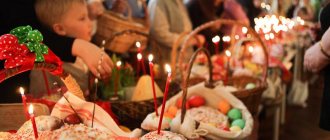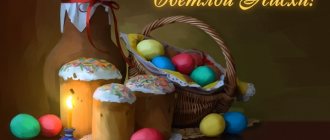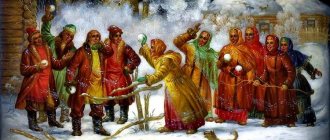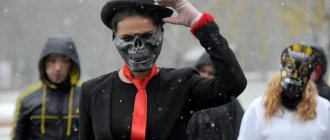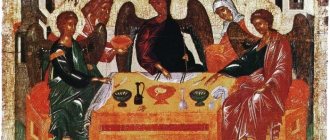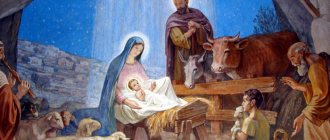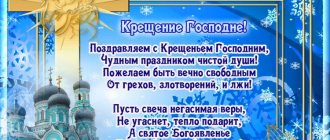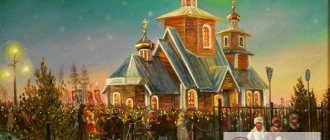The Day of the Nativity of Christ was established by the Church in honor of an event that happened on earth 2015 years ago; This is one of the twelve main holidays of the annual liturgical cycle.
The Nativity of Christ is the great twelfth holiday. On Christmas night from January 6 to 7, a festive Divine Liturgy is celebrated. On Christmas Day itself, believers celebrate and feast - “break their fast” (now it is allowed to eat not only fasting food, but also “meat” food). The twelve days following Christmas are called “holy days” or “holy holidays”.
Questions and Answers What is Christmastide? Celebration traditions
How Christmas is celebrated in modern Russia
Christmas continues the series of New Year holidays, so the streets of cities and villages are already decorated with illumination and garlands. Large live or artificial Christmas trees with New Year's paraphernalia are installed in the squares in the center.
Every family prepares for the New Year and Christmas: they buy and decorate a Christmas tree (why they decorate a Christmas tree, I wrote about this here), and decorate the house. Household members are sure to plan gifts and congratulations for each other. Souvenirs, gifts and decorations made with your own hands are especially valued. Children await this event with the greatest trepidation, because they believe in miracles and fairy tales.
On the eve of the holiday itself, Orthodox believers go to services in Temples, where Great Compline and All-Night Vigil take place. Christmas services from January 6 to 7 from the Cathedral of Christ the Savior in Moscow are usually broadcast on federal channels. The solemn service is headed by the Patriarch of All Rus' himself.
All-Night Vigil
The long Nativity Fast ends with the celebration of Christmas. Housewives pay special attention to preparing traditional dishes. On January 7, Christians are allowed to eat a large meal without restrictions. Each housewife is free to decide for herself what treats to put on the Christmas table. Usually they prepare pies, salads, jellied meat, bake goose or chicken with apples and treat family and friends with all kinds of desserts.
Modern traditions
Currently, every Russian family loves and celebrates this event. In the evenings, young girls continue to guess about their betrothed and count the number of future children. On the night before Christmas, all of Russia makes wishes. Young people meet in the central square, and cultural institutions organize various events and competitions for people of all ages. The city administration decorates the Christmas tree, makes slides and labyrinths to make the holiday widespread.
Only holidays have been shortened, since now the weekend begins with the New Year's feast. Two days after celebrating such a bright day as Christmas, people go to work. But after the first working week, they happily celebrate the Baptism of Rus', which used to end the Christmas festivities.
Much attention is paid to gifts these days. Buying and giving gifts at Christmas has become a modern tradition. The idea was quickly picked up by commercial structures and today on the shelves we see not only New Year’s, but also Christmas gifts.
Christmas traditions and customs of the Russian people
Among the most famous Russian customs and traditions associated with the Christmas holidays, it is worth highlighting:
- Caroling. Everyone knows the old custom of Christmas carols, when children and youth go from house to house, glorify Christ in songs and poems, sing different wishes for people, and for this they receive a sweet treat or reward in the form of coins. Even now, children carol: they dress up and walk around apartments and houses, sing songs, recite poems for Christmas.
- Divination. Christmas is the beginning of the Christmastide (holy days), which continues until the day of Epiphany (January 19). In the Christmas tradition, this period was considered the most favorable for fortune telling. I was especially attracted to fortune telling as a way of predicting the fate of unmarried girls. They liked to carry out rituals at midnight in the dark and by candlelight, which created a particularly mystical atmosphere. They also used the melted candle wax, which they poured into water, and tried to discern the image of the frozen figure. Fortune telling using coffee or tea grounds was also common. Not without a mirror.
- General cleaning of the house. For Christmas, the owners always cleaned the huts, heated the baths, laid out a clean tablecloth, and prepared new clothes for the holiday.
- Special decoration for the festive table at Christmas. Housewives put hay under the tablecloth, which symbolized the manger of Jesus Christ. An iron object (an ax) was often placed under the table, on which guests placed their feet, which symbolized good health and a strong spirit. Coins, bills, salt and garlic were placed in the corners of the table for well-being in the house.
- Prohibition of work on Christmas Day. On the holiday itself, they didn’t do anything: they didn’t weave, didn’t sew, didn’t cook or clean the house under fear of troubles and misfortune.
- An invitation to a festive dinner for familiar lonely people, wanderers and orphans.
Caroling at Christmas
Fortune telling for Christmas
Festive table for Christmas
And this is not a complete list of all the customs and traditions for Christmas. What else special did they do on this day in Russia? For example, during the celebration, the legs of the dining table were tied with a rope to prevent livestock from escaping from the herd. After the morning service, the priests went around the houses of the parishioners and performed the “glorification” of God (glorifying Christ). And the leftovers from the evening meal were taken outside the yard so that the wolves, “having tasted and learned human kindness,” would not harm the peasant cattle.
It is important to know! Caroling and fortune-telling, which have survived to modern times, are “near-Christmas” customs, as they go against the spiritual meaning of the Orthodox holiday of Christmas, due to their pagan origin.
But despite this, they are firmly entrenched in Russian culture.
Merry Carols
Christmas carols were and remain no less entertaining. Of course, in our time it is more difficult to carry out such a ritual, since a large number of cities have appeared. In rural areas, especially if we are talking about pre-revolutionary times, carols were a colorful and favorite ritual for both children and adults. Carolers, with bags of millet, millet and other grains, walked from yard to yard. They showered the owners and their houses with cheerful shouts, wishing them happiness, wealth, health and fertile land. For example:
“We sow, we sow, we sow, we desire piety.”
People wished each other harvest, children, wealth, peace and all the best. In response, the owners treated them to festive food - fluffy bread, rolls, and pies. It was impossible not to treat the caroler; the owners of the courtyard, who drove away the carolers, were considered greedy, and the act did not bode well for them. Today, throughout the Christmas week, children go from house to house and apartment, recite poems, chants, and receive candy and other sweets for their efforts.
History of Christmas celebrations in Russia
In Russia, Christmas began to be celebrated after the baptism of Rus' by Prince Vladimir in 988. The holiday was always accompanied by the glorification of Jesus Christ, but also by folk festivities. In the 17th and 18th centuries, a tradition arose in Russia of arranging a den theater: scenes about the birth of Christ were acted out in a den box with the help of rag dolls. In the 19th century, a decorated Christmas tree became a symbol of Christmas everywhere, and in the 20th century, the one who brings gifts to children, Father Frost, appeared.
Baptism of Rus' by Prince Vladimir
After the October Revolution in 1917, the Soviet government banned the celebration of Christmas and all customs associated with this date. In 1935, the Christmas tradition of decorating trees was transferred to the celebration of the secular New Year. The Bethlehem stars on the tops of the trees were replaced with five-pointed ones. Gifts and visits to Santa Claus also became part of New Year's traditions, ceasing to be Christmas traditions. In 1937 in Moscow, for the first time, the Snow Maiden became Santa Claus' companion and granddaughter - a new character not associated with the Christmas holiday. Thus, during Soviet times, the emphasis was completely shifted from Christmas to New Year celebrations and nothing has changed until now.
October Revolution
In 1990, the Christmas holiday on January 7 was revived at the federal level and declared an official non-working day. The procedure is still in effect today.
Why is Christmas celebrated on January 7 in Russia?
With the accepted Orthodox faith, Christmas appeared in Russia. The holiday was celebrated everywhere on December 25th. But centuries later, the date shifted to January 7 due to the adoption of a different chronology system.
It's all about different calendars: Julian and Gregorian.
- Julian calendar in 46 BC e. introduced by the ancient Roman statesman Julius Caesar. Christian countries have used the calendar since the 6th century. However, it has inaccuracies: the calendar year was 11 minutes longer than the solar year. Every 128 years, the extra minutes created an extra day. After 1500 years, the calendar lagged behind the tropical year by 10 days, and by the 20th century the difference was already 13 days. That is why at the end of the 16th century a new, more accurate calendar appeared.
- In the 16th century, Pope Gregory XIII switched Rome to a different calendar, called the “Gregorian” calendar in his honor. Subsequently, most countries of the world switched to a similar chronology system. But Patriarch of All Rus' Jeremiah II decided that Russia had a special path of development and refused to introduce a new calendar. After the Bolsheviks came to power, the Gregorian calendar was nevertheless introduced, but the Orthodox Church remained orthodox - it did not change the chronology system, and therefore Orthodox Christmas is celebrated exactly two weeks later than the Catholic one - on January 7.
Julian and Gregorian calendars
Interesting! In 2100, due to the inaccuracy of the Julian calendar, Christmas will fall on January 8th!
How Christmas was celebrated in the old days in Rus'
A 40-day fast was always observed before Christmas. On the eve of the holiday, on Christmas Eve, the Orthodox did not eat food until the first star appeared in the sky. We dined on kutya (sochivom) - porridge cooked from barley or wheat, flavored with honey and raisins. It was also desirable to have 12 Lenten dishes at the meal (according to the number of Apostles). The table was covered with straw and a tablecloth on top.
At Christmas, they took a straw out from under the tablecloth and told fortunes. If it is long, there will be a generous season for flax, and if it is short, there will be a lean season. The girls gathered, picked up snow in their palms and threw it against the wind. If you hear him fall, wait for the groom - a handsome young man, and if the snow fell silently - an ugly old man. In the courtyards of houses there was a custom of burning straw stacks. They built it from straw and then burned it. The whole family and relatives watched this in absolute silence. It was believed that ancestors who had passed on to another world came to warm themselves by the fire lit by their descendants and could bring fertility to the earth.
Kutya at Christmas
Christmas table in Rus'
For the festive meal, they baked rolls, perepechi (rye koloboks), dough figures in the form of various livestock animals, and gave them to relatives and friends. The special dishes on the table were pig and goose with apples.
Christmas in Tsarist Russia
On Christmas in pre-revolutionary Russia, all the people were just beginning to celebrate, because Christmastide was ahead, right up to Epiphany. According to the covenant of the church, Orthodox Christians were supposed to sacredly observe these 12 days. It was forbidden to get married, to dance, to sing riotous songs. But everywhere these rules were violated by pagan fortune-telling, mummery and other customs.
Christmas has always been celebrated on a grand scale. In the 19th century, the custom of decorating the spruce appeared, which was introduced by the future Empress Alexandra Feodorovna at the Imperial Court. First, this tradition spread in aristocratic circles, and then among the people. And already in all families at home, Christmas trees were decorated, gifts were prepared for relatives. Christmas tree decorations were a separate form of art, as they were often made by household members. Lush Christmas balls with masquerades and theatrical performances were held in high society. Ordinary people actively participated in Christmas fun: skating, horseback riding, sledding, ice slides specially equipped for skating. They built a staircase, and watered the flooring itself, which instantly turned into smooth ice.
There was a special festive atmosphere in the Winter Palace. The entire royal family prayed at the All-Night Vigil service in the Palace Church. After it, all family members went to the Palace Living Room, where there was a separate Christmas tree for each. Gifts were selected individually for each member of the royal family, taking into account the wishes and hobbies. There were always guests at the holiday, almost family members: nannies, teachers, maids of honor. A festive lottery was held - the winner received a gift personally from the hands of the Empress.
Christmas tree before the Revolution
Christmas tree in the Romanov family
Christmas tree in Tsarist Russia
Faith played a big role in the life of the country and society, and Christmas was the most important winter holiday in Tsarist Russia.
On a note! New Year's Eve from December 31 to January 1 in pre-revolutionary Russia was not considered a special holiday occasion, but was simply the boundary between the old and new years.
Christmas fortune telling for children
The most interesting part of Christmas is the games and all kinds of fortune tellers. Absolutely everyone can take part in them, but, as a rule, the fairer sex and children are always interested.
Christmastide begins on January 6, each day of which is prophetic.
Therefore, before the Epiphany frosts, you can tell fortunes to know exactly what awaits us in the near future.
I will not list all kinds of fortune telling for unmarried ladies, but will name only the most interesting ones for children. You can use them to diversify your leisure time on holiday:
| Divination | Description |
| On rice grains | Invite your child to ask himself a question that can be answered either “Yes” or “No.” After this, he must put his pen into the bag of rice and pull it out. Then the number of grains stuck to the palm is counted. If there is an even number, then the answer to the question is NO, but if there is an odd number, then the answer is YES. |
| On tangerines | Invite your child to ask himself a question that can be answered either “Yes” or “No.” After this, he must peel the tangerine and count the number of slices. If there are an even number of them, then the answer is YES, and if there is an odd number, then the answer is NO. |
| On the ice | Pour water into a plate and leave it in the cold overnight. After this, see how the ice freezes. If it rises a little, then the year will be good and kind, but if it freezes evenly, then the year will be calm and quiet. If waves form on the ice, then there will be both joys and troubles in the year. |
will behave well, do good deeds and achieve their goals. This way you will motivate them to obey.
How to celebrate Christmas correctly?
Symbols of Christmas in Russia
All existing New Year symbols were once Christmas symbols. Nowadays, many have begun to forget how they used to celebrate Christmas, and the younger generation may not know this at all. So, the main symbols with which Christmas is associated:
- Decorated Christmas tree. Perhaps the most important symbol of the holiday. The tradition of installing a green tree comes from the story of the birth of Jesus Christ. His parents Mary and Joseph hid the baby in a cave, covering the entrance with fir branches.
- The star of Bethlehem decorating the top of the fir tree. When Jesus Christ was born in Bethlehem, a new star rose in the sky, which was brighter than all the others. This is where the tradition of installing such a symbol on the top of the Christmas tree arose.
- A nativity scene is a composition of sculptures depicting the Birth of Christ based on biblical scenes.
- Candles. Previously used to decorate Christmas trees. Now they are lit in churches during services and festive meals.
- Figures of angels and bells. When Jesus Christ was born, an angel descended to earth and announced the birth of the Savior. Angel figurines are presented as souvenirs to family and friends. The ringing of bells announces Christmas to everyone.
Christmas candles
Nativity scene for Christmas
Christmas tree
Christmas bells
All symbols of Christmas have a deep meaning and are inextricably linked with the story of the birth of Jesus Christ.
All-night vigil
The All-Night Vigil is a liturgical service that consists of Vespers and Matins, which received these names based on the time they took place. Before the holidays, morning and evening services are combined into the so-called “all-night vigil,” that is, prayer that continues all night. This prayer happens only twice a year - at Christmas and Easter. Before Christmas, at the All-Night Vigil, they serve not Vespers, but Great Compline (it is performed after Vespers served on Christmas Eve, hence the name).
What do Russians cook for Christmas?
On Christmas Eve, only strictly Lenten food is allowed. The traditional dish on Christmas Eve, which takes place on Christmas Eve, is “sochivo” - whole grain wheat porridge, to which honey, poppy seeds, nuts, dried fruits, and jam are added. A classic drink is “uzvar” (“brewed”) - brewed dried fruits and berries.
And what they eat at Christmas should already be especially nourishing and tasty. The most important meat dishes on the festive table are pork, lamb and poultry. But important national dishes for Christmas are goose, roasted whole, in apples and sauerkraut, and baked pig with horseradish.
Sochivo
Uzvar
Goose with apples
Roasted pig with horseradish
Goose (duck) recipe, 19th century:
“Having slaughtered and plucked a goose or duck, remove the entrails from them with a knife, scoop out the neck and wings, wash and, having seasoned with a pin, fry on a spit or in the oven, greasing with oil and salt; watch so that they don’t burn.”
Piglet recipe, early 20th century:
“Clean the pig well, remove the offal, boil it in salted water; and then chop them up with hard-boiled eggs, dilute with raw eggs and then stuff the pig, sew up the cut, coat with butter and put in the oven to roast. When it is well browned, pour the juice it gives onto the pig.”
Jellied meat, salads, and baked goods are often prepared for the Christmas table. At Christmas they bake pies, pies, kulebyaki, and pancakes from oatmeal (oatmeal).
Traditional Russian drinks, such as sbiten, mead, kvass and jelly, were necessarily prepared for the festive table in advance. In modern times, housewives cook and serve compotes, and of course, the usual tea, coffee and alcoholic drinks.
Traditional Christmas desserts in ancient times were sweet rolls and honey gingerbread. Nowadays, sweets can be of absolutely any type: sweets, cakes, pastries, and so on.
Aspic
Christmas wreath salad
Pie for Christmas
Kulebyaka
Rasstegai
Oatmeal pancakes
Mead
Kissel
Sbiten
All dishes are prepared for Christmas with special care and love, which is why they are incredibly tasty. And the variety of treats on the festive table always surprises dear guests.
Why is Christmas necessary?
God comes into our world in the silence of the Bethlehem night, and the very fact of His birth is already our approach to God, because, in the words of Metropolitan Anthony of Sourozh: “Every person, by the very fact that he is a person, is involved in the mystery of Christ.” From now on, man is not alone in this world. “Christ became a Man so that all of us, all of us without a trace, including those who have lost all faith in themselves, would know that God believes in us, believes in us in our fall, believes in us when we ourselves have believed in each other.” friend and in himself, believes so much that he is not afraid to become one of us.” “God became Man so that man could become God,” this is how the 2nd century Hieromartyr Irenaeus of Lyons formulated the great mystery of the incarnation.
What do they give for Christmas in Russia?
Preparing for Christmas also includes preparing gifts. At Christmas, family and friends are given symbolic gifts, because the holiday is, first of all, spiritual. For example, candles are a common gift at Christmas because they bring peace and tranquility. There is a huge variety of colors and shapes of candles - you can always find a suitable idea. An excellent option is a Christmas souvenir in the form of an angel or bell, which can be placed on a shelf or hung on a tree.
Candles for Christmas
In Tsarist Russia they loved to give each other hand-made Christmas cards with wishes. This tradition continues to this day; children especially love to create homemade gifts, and cards are no exception. And always a win-win option is a gift with sweets: cookies, candies, gingerbread. A sweet surprise will be pleasant for everyone, young and old.
How did the world learn about the birth of the Savior, how did the world perceive it?
The Bethlehem shepherds are the first to learn about the birth of the Savior. That night they are grazing their flocks in the field, when suddenly an Angel of God appears before them: “Do not be afraid! - he says, - I proclaim to you great joy, which will be not only for you, but also for all people: today the Savior has been born in the city of David (i.e. in Bethlehem)! Here is a sign for you: you will find a Child wrapped in swaddling clothes, lying in a manger.”
But the shepherds were not the only ones who worshiped the Infant God. The Mother of God and Joseph, together with the Infant Jesus, were still remaining in Bethlehem, when the wise men and astrologers came from the distant east to Jerusalem. They, too, had long been awaiting the birth of the One who would become the Messiah - the Savior. In Jerusalem, strangely dressed strangers from the east begin to ask: “Where is the newborn King of the Jews? We saw His star rising and came to worship Him!” Hearing this, the suspicious and cruel king of Judea Herod “was agitated, and with him all Jerusalem.” From experts in the Holy Scriptures, frightened Herod learns that the prophets foretold the birth of the King of the Jews, the Savior, in the line of David, in the city of Bethlehem. It does not even occur to the suspicious Herod that the kingdom of the newborn Ruler of Israel will be “not of this world,” that we are not talking about an earthly kingdom, but about the Kingdom of Heaven. This is all too difficult for the cruel impostor Herod. And Herod is truly a monster - he ordered the execution of his wife and children only out of suspicion that they intended to deprive him of power.
So, having heard that a possible competitor had already been born, Herod calls the unsuspecting magi to himself, finds out from them the time of the birth of the Messiah and sends them to Bethlehem with an insidious order: “Go, carefully investigate about the Baby and, when you find it, notify me.” so that I too can go and worship Him.”
The Magi head to Bethlehem, and a new star shows them the way.
"Nativity". Photo: Icon painting workshop of the Holy Trinity Church in Kursk
So, led by the star, the Magi go to Bethlehem. And the star stopped “over the place where the Child was. Seeing the star, they rejoiced with very great joy, and, entering the house, they saw the Child with Mary, His Mother, and, falling down, they worshiped Him; and having opened their treasures, they brought Him gifts: gold, frankincense and myrrh. And having received a revelation in a dream not to return to Herod, they departed to their own country by a different route. When they departed, behold, the Angel of the Lord appears to Joseph in a dream and says: get up, take the Child and His Mother and flee to Egypt, and be there until I tell you, for Herod wants to look for the Child in order to destroy Him. ..."
Thus, with homelessness and wanderings, the life of Christ begins.
When the Savior was born, people reacted differently to this event. Some, like the Magi, with a pure heart went to meet Him to rejoice. Others, like Herod, decided to destroy Him. There were also indifferent people who did not allow the Mother of God into their house to spend the night. They didn’t care, they were incapable of mercy, of compassion. It is with the tacit consent of such people that evil is committed. Both those, and others, and others are among us. And each of us faces a choice every day: who is he with? Where is he? With Christ, or for Herod? Or maybe he just hid in his cozy little world and won’t let someone else’s misfortune and pain in, and, therefore, won’t let the Lord in either.
Ritual for health at Christmas time
You can also carry out a health conspiracy that will allow household members to recover and strengthen the immune system. There are several ways to carry out a conspiracy.
Health ritual for Christmas time:
- One of the simplest is the ritual with a towel. You need to purchase a new linen towel that has never been used. Next, words are spoken.
- Next, you need to say the name of the person who will be dried with this towel, and whose health you want to improve.
- It is necessary for a person to use the enchanted towel for a long time. This ritual takes place on the 6th.
Conspiracy words:
In the name of father and son and the holy spirit, I speak against 70 ailments.
Christmas

